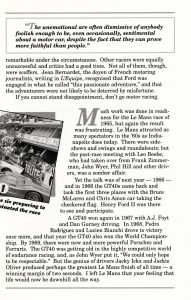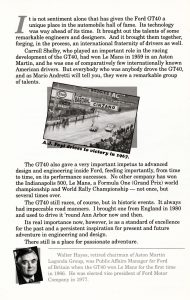This Passionate Adventure: 30 years of the Ford GT 40
A personal reflection by Walter Hayes
Ford Motor Company commemorative brochure, 1994
Car and Driver called ‘the first true sports car to come out of Detroit’ round the track at Watkins Glen, reaching a speed of 120 miles an hour on the straight. The London Sunday Times said it was “quite the most exciting vehicle of its class to have appeared for years.”
It was nearly 500 pounds lighter than its Porsche counterpart – with a midships engine, rear drive – and, in appearance, years ahead of all its competitors.
It was called Mustang I.
Despite worldwide interest, Mustang I was not destined for production. It was more a symbol of Ford’s dedication to the young-at-heart and the herald of the company’s new commitment to Total Performance.
About a month before Dan Gurney drove round the Glen, the policy committee of Ford Motor Company had given approval to a more practical and more affordable production car, which was to become the Ford Mustang. It went into dealerships on April 17, 1964. Priced at $2,368, it sold 418,812 in its first year.
Although the connection is not often made, Mustang I also had been the inspiration for another car that now – depending on the version – can sell for $1 million. The year 1994 was its 30th birthday and, in that period of time, it has become immortal – and that is not too strong a word.
It was called the GT 40.
The sheer joy of car ownership in the ‘60s, and the near veneration of the great cars that came to life in that decade, are hard to imagine now. In Europe, a car of one’s own was synonymous with at least modest riches until 1955. But the love affair had started. Total Performance was an exact reflection of the age, and no totem of that era was more deservedly worshipped than the GT 40.
It was built under wraps in the Ford Advanced Vehicle Studio in England. The intention (not merely ambition) was to win the 24 Hours of Le Mans, in France, the most famous race in the world at the time; the event that, over many years, had brought Bentley and Aston Martin and Jaguar, Ferrari, Mercedes and Porsche to worldwide attention.
Since the battleground was to be Europe, a transatlantic team was formed. Don Frey and Frank Zimmerman were in command, in Dearborn. John Wyer, general manager of Aston Martin, secured his release from that company to become racing manager, establishing a small factory in England for build and development. Bill Innes’s supreme engine division in Dearborn put all its skill into an unbreakable V8 that would run from 2 pm on a Saturday in June until 2 pm the following day, at an average speed of 120 mph. When John Wyer flew over to see the first clay model, he said it was “the most beautiful and functional car I had ever seen.” And when it was unveiled at the Essex House Hotel in New York on April 3, 1964 – the opening day of the New York Auto Show – his opinion was shared by everyone privileged to be there. I thought it was almost too beautiful to be functional.
“The unemotional are often dismissive of anybody foolish enough to be, even occasionally, sentimental about a motor car, despite the fact that they can prove more faithful than people.”
The ‘60s were not a patient time, and Ford was in a hurry. But it was still too much and too soon to expect victory at the more that year. The build of the GT40 had not been completed until April 1; there was only one other fully engineered vehicle, and Le Mans was only two months away. Nevertheless, three were entered.
In that race, two GT40s fell out after four hours, and the third, driven by Phil Hill and Bruce McLaren, lasted 13 hours, which was remarkable under the circumstances. Other racers were equally unsuccessful and critics had a good time. Not all of them, though, were scoffers. Jean Bernadet, the doyen of French motoring journalists, writing in L’Equipe, recognised that Ford was engaged in what he called “this passionate adventure”, and that the adventurers were not likely to be deterred by misfortune.
If you cannot stand disappointment, don’t go motor racing.
Much work was done in readiness for the Le Mans race of 1965, but again the result was frustrating. Le Mans attracted as many spectators in the ‘60s as Indianapolis does today. There were sideshows and swings and roundabouts; but the post race meeting with Leo Beebe, who had taken over from Frank Zimmerman, John Wyer, Phil Hill and other drivers, was a somber affair. Yet the talk was of next year – 1966 – and in 1966 the GT40s came back and took the first three places with the Bruce McLaren and Chris Amon car taking the checkered flag. Henry Ford II was there to see and participate.
A GT40 won again in 1967 with A.J. Foyt and Dan Gurney driving. In 1968, Pedro Rodriguez and Lucien Bianchi drove to victory once more, and that year the GT40 also won the World Championship. By 1969, there were new and more powerful Porsches and Ferraris. The GT40 was getting old in the highly competitive world of endurance racing, and, as John Wyer put it, “we could only hope to be respectable.” But the genius of drivers Jackie Ickx and Jackie Oliver produced perhaps the greatest Le Mans finish of all time – a winning margin of two seconds. I left Le Mans that year feeling that life would now be downhill all the way.
It is not sentiment alone that has given the Ford GT40 a unique place in the automobile Hall of Fame. It’s technology was way ahead of its time. It brought out the talents of some remarkable engineers and designers. And it brought them together, forging, in the process, an international fraternity of drivers as well.
Carroll Shelby, who played an important role in the racing development of the GT40, had won Le Mans in 1959 in an Aston Martin, and he was one of comparatively few internationally known American drivers. But everybody who is anybody drove the GT40, and as Mario Andretti will tell you, they were a remarkable group of talents.
The GT40 also gave a very important impetus to advanced design and engineering inside Ford, feeding importantly, from time to time, on his performance successes. No other company has won the Indianapolis 500, Le Mans, a Formula One Grand Prix world championship and World Rally championship – not once, but several times over.
The GT40 still races, of course, but in historic events. It always had impeccable road manners. I brought one from England in 1980 and used to drive it round Ann Arbor now and then.
Its real importance now, however, is as a standard of excellence for the past and a persistent inspiration for present and future adventure in engineering and design.
There still is a place for passionate adventure.
Walter Hayes, retired chairman of Aston Martin Lagonda group, was Public Affairs manager for Ford of Britain when the GT40 won Le Mans for the first time in 1966. He was elected Vice President of Ford Motor Company in 1977.



